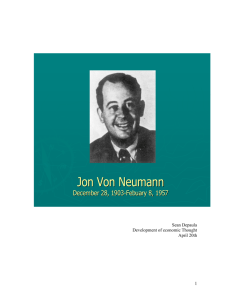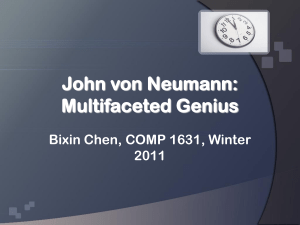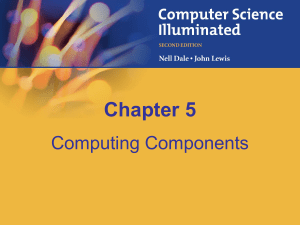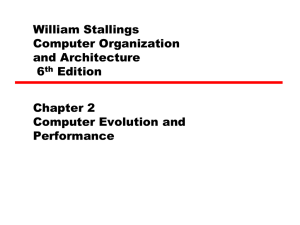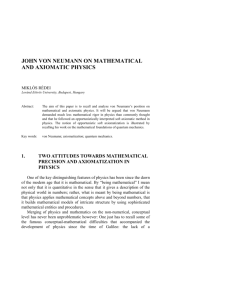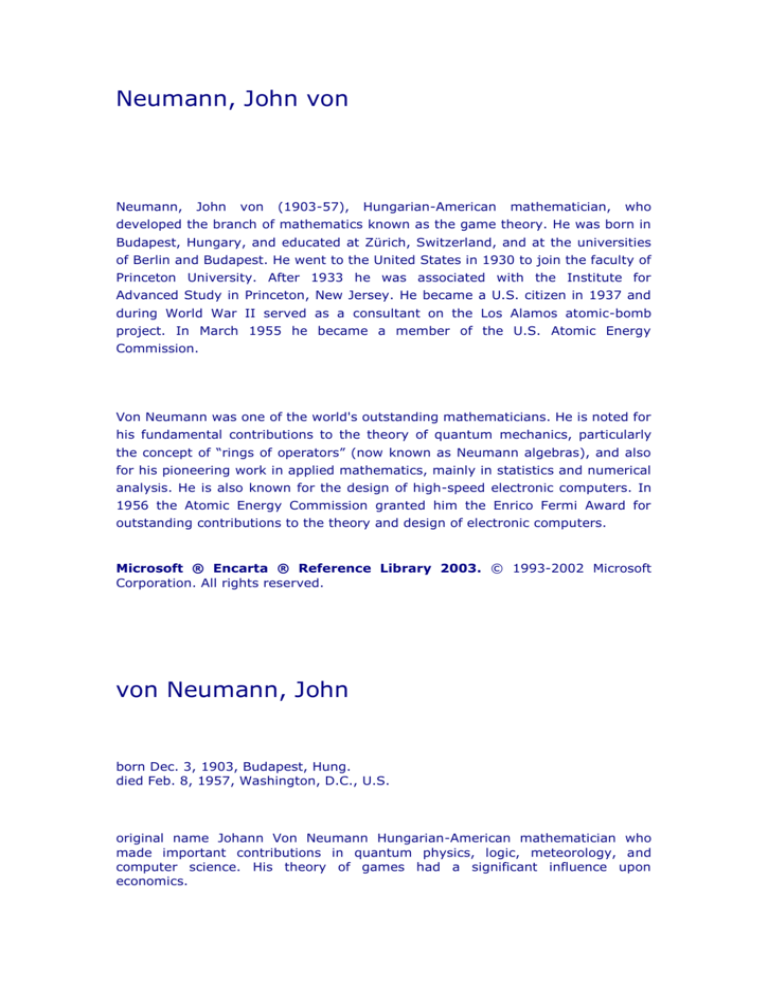
Neumann, John von
Neumann,
John
von
(1903-57),
Hungarian-American
mathematician,
who
developed the branch of mathematics known as the game theory. He was born in
Budapest, Hungary, and educated at Zürich, Switzerland, and at the universities
of Berlin and Budapest. He went to the United States in 1930 to join the faculty of
Princeton University. After 1933 he was associated with the Institute for
Advanced Study in Princeton, New Jersey. He became a U.S. citizen in 1937 and
during World War II served as a consultant on the Los Alamos atomic-bomb
project. In March 1955 he became a member of the U.S. Atomic Energy
Commission.
Von Neumann was one of the world's outstanding mathematicians. He is noted for
his fundamental contributions to the theory of quantum mechanics, particularly
the concept of “rings of operators” (now known as Neumann algebras), and also
for his pioneering work in applied mathematics, mainly in statistics and numerical
analysis. He is also known for the design of high-speed electronic computers. In
1956 the Atomic Energy Commission granted him the Enrico Fermi Award for
outstanding contributions to the theory and design of electronic computers.
Microsoft ® Encarta ® Reference Library 2003. © 1993-2002 Microsoft
Corporation. All rights reserved.
von Neumann, John
born Dec. 3, 1903, Budapest, Hung.
died Feb. 8, 1957, Washington, D.C., U.S.
original name Johann Von Neumann Hungarian-American mathematician who
made important contributions in quantum physics, logic, meteorology, and
computer science. His theory of games had a significant influence upon
economics.
Von Neumann studied chemistry at the University of Berlin and, at Technische
Hochschule in Zürich, received the diploma in chemical engineering in 1926. The
same year, he received the Ph.D. in mathematics from the University of
Budapest, with a dissertation about set theory. His axiomatization has left a
permanent mark on the subject; and his definition of ordinal numbers, published
when he was 20, has been universally adopted.
Von Neumann was privatdocent (lecturer) at Berlin in 1926–29 and at the
University of Hamburg in 1929–30. During this time he worked mainly on
quantum physics and operator theory. Largely because of his work, quantum
physics and operator theory can be viewed as two aspects of the same subject.
In 1930 von Neumann was visiting lecturer at Princeton University; he was
appointed professor in 1931. In 1932 he gave a precise formulation and proof of
the “ergodic hypothesis” of statistical mathematics. His book on quantum
mechanics, The Mathematical Foundations of Quantum Mechanics, published in
1932, remains a standard treatment of the subject. In 1933 he became a
professor at the newly founded Institute for Advanced Study, Princeton, keeping
that position for the rest of his life. Meanwhile, he turned his attention to the
challenge made in 1900 by a German mathematician, David Hilbert (q.v.), who
proposed 23 basic theoretical problems for20th-century mathematical research.
Von Neumann solved a special case of Hilbert's fifth problem, the case of compact
groups.
In the second half of the 1930s the main part of von Neumann's publications,
written partly in collaboration with F.J. Murray, was on “rings of operators” (now
called Neumann algebras). Of all his work, these concepts will quite probably be
remembered the longest. Currently it is one of the most powerful tools in the
study of quantum physics. An important outgrowth of rings of operators is
“continuous geometry.” Von Neumann saw that what really determines the
character of the dimensional structure of a space is the group of rotations that
the structure allows. The groups of rotations associated with rings of operators
make possible the description of space with continuously varying dimensions.
About 20 of von Neumann's 150 papers are in physics; the rest are distributed
more or less evenly among pure mathematics (mainly set theory, logic,
topological group, measure theory, ergodic theory, operator theory, and
continuous geometry) and applied mathematics (statistics, numerical analysis,
shock waves, flow problems, hydrodynamics, aerodynamics, ballistics, problems
of detonation, meteorology, and two nonclassical aspects of applied mathematics,
games and computers). His publications show a break from pure to applied
research around 1940.
During World War II, he was much in demand as a consultant to the armed forces
and to civilian agencies. His two main contributions were his espousal of the
implosion method for bringing nuclear fuel to explosion and his participation in
the development of the hydrogen bomb.
The mathematical cornerstone of von Neumann's theory of games is the
“minimax theorem,” which he stated in 1928; its elaboration and applications are
in the book he wrote jointly with Oskar Morgenstern in 1944, Theory of Games
and Economic Behavior. The minimax theorem says that for a large class of twoperson games, there is no point in playing. Either player may consider, for each
possible strategy of play, the maximum loss that he can expect to sustain with
that strategy and then choose as his “optimal” strategy the one that minimizes
the maximum loss. If a player follows this reasoning, then he can be statistically
sure of not losing more than that value called the minimax value. Since (this is
the assertion of the theorem) that minimax value is the negative of the one,
similarly defined, that his opponent can guarantee for himself, the long-run
outcome is completely determined by the rules.
In computer theory, von Neumann did much of the pioneering work in logical
design, in the problem of obtaining reliable answers from a machine with
unreliable components, the function of “memory,” machine imitation of
“randomness,” and the problem of constructing automata that can reproduce
their own kind. One of the most striking ideas, to the study of which he proposed
to apply computer techniques, was to dye the polar ice caps so as to decrease the
amount of energy they would reflect—the result could warm the Earth enough to
make the climate of Iceland approximate that of Hawaii.
The “axiomatic method” is sometimes mentioned as the secret of von Neumann's
success. In his hands it was not pedantry but perception; he got to the root of
the matter by concentrating on the basic properties (axioms) from which all else
follows. His insights were illuminating and his statements precise.
Game Theory
I
INTRODUCTION
Game Theory, mathematical analysis of any situation involving a conflict of
interest, with the intent of indicating the optimal choices that, under given
conditions, will lead to a desired outcome. Although game theory has roots in the
study of such well-known amusements as checkers, tick-tack-toe, and poker—
hence the name—it also involves much more serious conflicts of interest arising in
such fields as sociology, economics, and political and military science.
Aspects of game theory were first explored by the French mathematician Émile
Borel, who wrote several papers on games of chance and theories of play. The
acknowledged father of game theory, however, is the Hungarian-American
mathematician John von Neumann, who in a series of papers in the 1920s and
'30s established the mathematical framework for all subsequent theoretical
developments. During World War II military strategists in such areas as logistics,
submarine warfare, and air defense drew on ideas that were directly related to
game theory. Game theory thereafter developed within the context of the social
sciences. Despite such empirically related interests, however, it is essentially a
product of mathematicians.
II
BASIC CONCEPTS
In game theory, the term game means a particular sort of conflict in which n of
individuals or groups (known as players) participate. A list of rules stipulates the
conditions under which the game begins, the possible legal “moves” at each stage
of play, the total number of moves constituting the entirety of the game, and the
terms of the outcome at the end of play.
A
Move
In game theory, a move is the way in which the game progresses from one stage
to another, beginning with an initial state of the game through the final move.
Moves may alternate between players in a specified fashion or may occur
simultaneously. Moves are made either by personal choice or by chance; in the
latter case an object such as a die, instruction card, or number wheel determines
a given move, the probabilities of which are calculable.
B
Payoff
Payoff, or outcome, is a game-theory term referring to what happens at the end
of a game. In such games as chess or checkers, payoff may be as simple as
declaring a winner or a loser. In poker or other gambling situations the payoff is
usually money; its amount is predetermined by antes and bets amassed during
the course of play, by percentages or by other fixed amounts calculated on the
odds of winning, and so on.
C
Extensive and Normal Form
One of the most important distinctions made in characterizing different forms of
games is that between extensive and normal. A game is said to be in extensive
form if it is characterized by a set of rules that determines the possible moves at
each step, indicating which player is to move, the probabilities at each point if a
move is to be made by a chance determination, and the set of outcomes
assigning a particular payoff or result to each possible conclusion of the game.
The assumption is also made that each player has a set of preferences at each
move in anticipation of possible outcomes that will maximize the player's own
payoff or minimize losses. A game in extensive form contains not only a list of
rules governing the activity of each player, but also the preference patterns of
each player. Common parlor games such as checkers and ticktacktoe and games
employing playing cards such as “go fish” and gin rummy are all examples.
Because of the enormous numbers of strategies involved in even the simplest
extensive games, game theorists have developed so-called normalized forms of
games for which computations can be carried out completely. A game is said to
be in normal form if the list of all expected outcomes or payoffs to each player for
every possible combination of strategies is given for any sequence of choices in
the game. This kind of theoretical game could be played by any neutral observer
and does not depend on player choice of strategy.
D
Perfect Information
A game is said to have perfect information if all moves are known to each of the
players involved. Checkers and chess are two examples of games with perfect
information; poker and bridge are games in which players have only partial
information at their disposal.
E
Strategy
A strategy is a list of the optimal choices for each player at every stage of a given
game. A strategy, taking into account all possible moves, is a plan that cannot be
upset, regardless of what may occur in the game.
III
KINDS OF GAMES
Game theory distinguishes different varieties of games, depending on the number
of players and the circumstances of play in the game itself.
A
One-Person Games
Games such as solitaire are one-person, or singular, games in which no real
conflict of interest exists; the only interest involved is that of the single player. In
solitaire only the chance structure of the shuffled deck and the deal of cards come
into play. Single-person games, although they may be complex and interesting
from a probabilistic view, are not rewarding from a game-theory perspective, for
no adversary is making independent strategic choices with which another must
contend.
B
Two-Person Games
Two-person, or dual, games include the largest category of familiar games such
as chess, backgammon, and checkers or two-team games such as bridge. (More
complex
conflicts—n-person,
or
plural,
games—include
poker,
Monopoly,
Parcheesi, and any game in which multiple players or teams are involved.) Twoperson games have been extensively analyzed by game theorists. A major
difficulty that exists, however, in extending the results of two-person theory to nperson games is predicting the interaction possible among various players. In
most two-party games the choices and expected payoffs at the end of the game
are generally well-known, but when three or more players are involved, many
interesting but complicating opportunities arise for coalitions, cooperation, and
collusion.
C
Zero-Sum Games
A game is said to be a zero-sum game if the total amount of payoffs at the end of
the game is zero. Thus, in a zero-sum game the total amount won is exactly
equal to the amount lost. In economic contexts, zero-sum games are equivalent
to saying that no production or destruction of goods takes place within the “game
economy” in question. Von Neumann and Oskar Morgenstern showed in 1944 that
any n-person non-zero-sum game can be reduced to an n + 1 zero-sum game,
and that such n + 1 person games can be generalized from the special case of
the two-person zero-sum game. Consequently, such games constitute a major
part of mathematical game theory. One of the most important theorems in this
field establishes that the various aspects of maximal-minimal strategy apply to all
two-person zero-sum games. Known as the minimax theorem, it was first proven
by von Neumann in 1928; others later succeeded in proving the theorem with a
variety of methods in more general terms.
IV
APPLICATIONS
Applications of game theory are wide-ranging and account for steadily growing
interest in the subject. Von Neumann and Morgenstern indicated the immediate
utility of their work on mathematical game theory by linking it with economic
behavior. Models can be developed, in fact, for markets of various commodities
with differing numbers of buyers and sellers, fluctuating values of supply and
demand, and seasonal and cyclical variations, as well as significant structural
differences in the economies concerned. Here game theory is especially relevant
to the analysis of conflicts of interest in maximizing profits and promoting the
widest distribution of goods and services. Equitable division of property and of
inheritance is another area of legal and economic concern that can be studied
with the techniques of game theory.
In the social sciences, n-person game theory has interesting uses in studying, for
example, the distribution of power in legislative procedures. This problem can be
interpreted as a three-person game at the congressional level involving vetoes of
the president and votes of representatives and senators, analyzed in terms of
successful or failed coalitions to pass a given bill. Problems of majority rule and
individual decision making are also amenable to such study.
Sociologists have developed an entire branch of game theory devoted to the
study of issues involving group decision making. Epidemiologists also make use of
game theory, especially with respect to immunization procedures and methods of
testing a vaccine or other medication. Military strategists turn to game theory to
study conflicts of interest resolved through “battles” where the outcome or payoff
of a given war game is either victory or defeat. Usually, such games are not
examples of zero-sum games, for what one player loses in terms of lives and
injuries is not won by the victor. Some uses of game theory in analyses of
political and military events have been criticized as a dehumanizing and
potentially dangerous oversimplification of necessarily complicating factors.
Analysis of economic situations is also usually more complicated than zero-sum
games because of the production of goods and services within the play of a given
“game.”
Contributed By: Joseph Warren Dauben
Microsoft ® Encarta ® Reference Library 2003. © 1993-2002 Microsoft
Corporation. All rights reserved.


